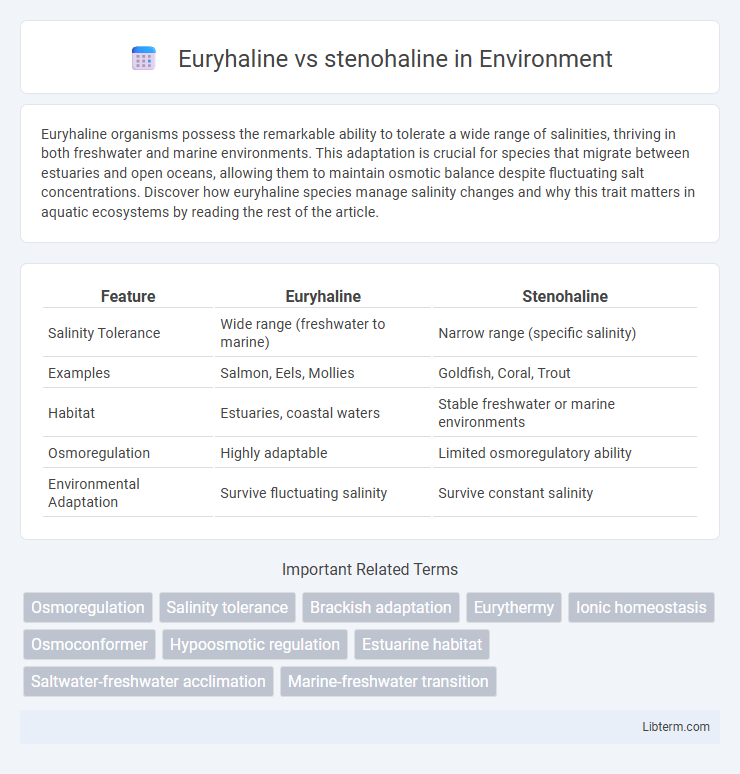Euryhaline organisms possess the remarkable ability to tolerate a wide range of salinities, thriving in both freshwater and marine environments. This adaptation is crucial for species that migrate between estuaries and open oceans, allowing them to maintain osmotic balance despite fluctuating salt concentrations. Discover how euryhaline species manage salinity changes and why this trait matters in aquatic ecosystems by reading the rest of the article.
Table of Comparison
| Feature | Euryhaline | Stenohaline |
|---|---|---|
| Salinity Tolerance | Wide range (freshwater to marine) | Narrow range (specific salinity) |
| Examples | Salmon, Eels, Mollies | Goldfish, Coral, Trout |
| Habitat | Estuaries, coastal waters | Stable freshwater or marine environments |
| Osmoregulation | Highly adaptable | Limited osmoregulatory ability |
| Environmental Adaptation | Survive fluctuating salinity | Survive constant salinity |
Understanding Euryhaline and Stenohaline Organisms
Euryhaline organisms possess the ability to survive in a wide range of salinities, making them adaptable to both freshwater and marine environments, such as salmon and bull sharks. Stenohaline organisms, on the other hand, can tolerate only a narrow salinity range, typically restricted to either strictly freshwater or marine habitats, like most freshwater fish or coral species. This distinction is crucial for ecological studies and aquaculture, as it influences species distribution, osmoregulation mechanisms, and habitat conservation strategies.
Defining Euryhaline: Adaptation to Varying Salinities
Euryhaline organisms possess the biological capacity to tolerate a wide range of salinities, enabling survival in environments such as estuaries and brackish waters. This adaptability involves specialized osmoregulatory mechanisms that balance internal salt concentrations despite fluctuating external salinity levels. In contrast, stenohaline species are restricted to narrow salinity ranges, limiting their habitat distribution to either strictly freshwater or marine ecosystems.
Stenohaline Species: Thriving in Stable Salinity
Stenohaline species thrive exclusively in environments with stable salinity levels, typically found in marine or freshwater habitats where salinity fluctuations are minimal. Their physiological adaptations limit their ability to osmoregulate across varying salt concentrations, making them vulnerable to salinity changes caused by environmental disturbances. Examples include many freshwater trout and marine coral species, which require consistent osmotic conditions for survival and reproduction.
Physiological Mechanisms of Salinity Tolerance
Euryhaline organisms possess specialized osmoregulatory cells, such as chloride cells in their gills, which actively regulate ion exchange to maintain homeostasis across a wide range of salinities. In contrast, stenohaline species have limited osmoregulatory capacity, relying heavily on stable extracellular fluid composition and exhibiting less efficient ion transport mechanisms. Molecular adaptations in euryhaline species include upregulation of ion transporters like Na+/K+-ATPase and aquaporins, enabling rapid physiological adjustments to fluctuating salinity levels.
Key Examples of Euryhaline Animals
Euryhaline animals, such as the Atlantic salmon (Salmo salar) and the bull shark (Carcharhinus leucas), can tolerate a wide range of salinities, enabling them to thrive in both freshwater and marine environments. In contrast, stenohaline species like the goldfish (Carassius auratus) are limited to narrow salinity ranges, typically inhabiting either freshwater or saltwater exclusively. Euryhaline capability is crucial for species that migrate between environments, supporting ecological versatility and survival across fluctuating salinity gradients.
Notable Stenohaline Species in Aquatic Environments
Notable stenohaline species in aquatic environments include freshwater fish like trout (Oncorhynchus mykiss) and marine species such as the Atlantic cod (Gadus morhua), which thrive within narrow salinity ranges and cannot tolerate significant fluctuations in salt concentration. These species exhibit specialized physiological adaptations limiting their osmoregulatory capacity to stable habitats, playing critical roles in freshwater and marine ecosystems. The ecological distribution of stenohaline species is tightly linked to consistent salinity conditions, distinguishing them fundamentally from euryhaline species capable of enduring diverse salinity levels.
Ecological Significance of Salinity Adaptation
Euryhaline species exhibit remarkable ecological significance by thriving across a wide range of salinities, enabling them to colonize diverse habitats such as estuaries, tidal zones, and brackish waters. In contrast, stenohaline organisms have narrow salinity tolerance, restricting their distribution to stable environments like open oceans or freshwater systems, which influences ecosystem zonation and biodiversity. Salinity adaptation in these species underpins critical ecological processes including nutrient cycling, habitat connectivity, and resilience to environmental change in aquatic ecosystems.
Evolutionary Perspectives on Salinity Tolerance
Euryhaline species exhibit remarkable evolutionary adaptations allowing them to tolerate wide salinity gradients through specialized osmoregulatory mechanisms, enabling survival in both freshwater and marine environments. Stenohaline organisms have evolved more restrictive ion regulation systems, limiting their habitat to narrow salinity ranges, often reflecting stable ecological niches. Comparative genomic studies reveal that expansions in gene families related to ion transport and stress response underpin the divergence between euryhaline and stenohaline lineages in their salinity tolerance evolution.
Impacts of Climate Change on Salinity Adaptations
Euryhaline species, capable of tolerating wide salinity fluctuations, exhibit greater resilience to climate change-induced salinity shifts in coastal and estuarine ecosystems compared to stenohaline species, which thrive only within narrow salinity ranges. Rising sea levels and altered precipitation patterns increase salinity variability, challenging stenohaline organisms' osmoregulatory mechanisms and potentially leading to population declines. Understanding these adaptive differences is crucial for predicting species distribution changes and managing biodiversity in shifting aquatic environments.
Euryhaline vs Stenohaline: Implications for Aquaculture
Euryhaline species, capable of tolerating a wide range of salinities, offer significant advantages for aquaculture by enabling flexible farming in varying aquatic environments, including brackish and marine waters. In contrast, stenohaline species, which tolerate only narrow salinity ranges, require more controlled and stable salinity conditions, increasing management complexity and costs in aquaculture systems. Selecting euryhaline species can enhance productivity and reduce risks associated with salinity fluctuations, making them ideal candidates for sustainable aquaculture operations.
Euryhaline Infographic

 libterm.com
libterm.com